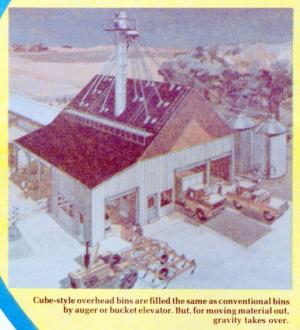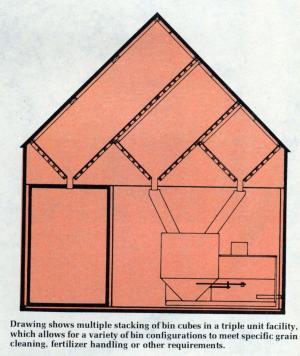1978 - Volume #2, Issue #5, Page #01
[ Sample Stories From This Issue | List of All Stories In This Issue | Print this story
| Read this issue]
New Way To Handle, Store Grain
 |
 |
"It's an entirely new concept in farm buildings, designed for oneman operation and easily adaptable to virtually every present on-farm grain handling operation. It can be custom-built to tie into your existing setup to give you high speed handling and other exclusive features which the system provides," Martel told FARM SHOW.
Plans for marketing the new concept, which has been under extensive research and development for the past 10 years, were being finalized as this issue went to press. The new concept is based on moving large amounts of grain in a short time utilizing the principle of gravity. As shown in the accompanying illustrations, the system consists of wooden 8 x 8 x 8 ft. cubes or bins. They each hold 368 bu, of grain and can be subdivided or expanded in any direction in 4 ft. increments. Individual cubes can also be ganged in single, double or triple units to provide whatever capacity is necessary for a farmer's present and future storage-handling requirements.
Each cube has a slot opening on the bottom (4 ft. long and 11 in. wide) which converges to a 10 in. sq. outlet, allowing a 400 bu. truck to be gravity filled in a matter of minutes. The cubes can be elevated as high as necessary to clear straight trucks or semi's for fast loading via gravity flow.
Here, according to Martel, are other key features of the new gravity flow system:
• Flexibility and versatility. Ties into your existing system, or it can be built from scratch in whatever size you need. Although grain or dry fertilizer can be permanently stored in the elevated cubes, they're primarily designed for high speed handling of grain going in or out of conventional bin storage. Generally, it's cheaper to use conventional bins for long term storage of the grain. If you already have a grain storage system built around a bucket elevator, for example, the JBC gravity flow system can be tied into it to facilitate faster, more versatile grain handling, cleaning, treating or processing.
•To cut costs, a single, double or triple cube system can be built on exposed stilt-type support legs - without any siding covering the supporting framework. Grain can be loaded into overhead cubes with a conventional auger-type elevator rather than investing in a more expensive bucket type elevator.
• By adding siding and doors, you can use the area underneath the elevated bins as a machinery storage area, or a bulk material storage bin. Four rows of supports form 3 lanes underneath the triple bin unit. Each lane can be used to protect equipment and machinery in the offseason.
• Double or triple units provide the greatest flexibility in handling grain or fertilizer. A double unit, for example, is an ideal unit to combine with a grain cleaning operation. Wheat can go in one compartment, flax in another and corn fills the third compartment. Yet, there's still enough room to store a bulk load of fertilizer, or to hold last year's oats crop until prices go up.
• Each compartment or cube has its own unloading chute so there's instant access to each stored commodity.
• Individual cubes are preassembled out of exterior grade plywood sheets. For certified seed operators, the plywood sheets can be spraytreated at the factory with a urethane coating.
• Fragile specialty crops, such as edible beans, can be given soft, gentle handling to minimize kernel damage.
• The entire gravity flow operation is designed for one man operation to handle, process, treat or clean virtually all types of grain and feedstuffs.
As a ballpark cost figure, a 6,600 bu. capacity JBC gravity-flow setup would run about $40,000, including labor, foundation, and siding to enclose the facility. The unit could be tied into 100,000 or more bushels of existing grain storage to facilitate high speed handling, loading; treating and so forth.
The first on-farm JBC system was installed a year

Click here to download page story appeared in.

Click here to read entire issue
To read the rest of this story, download this issue below or click here to register with your account number.




